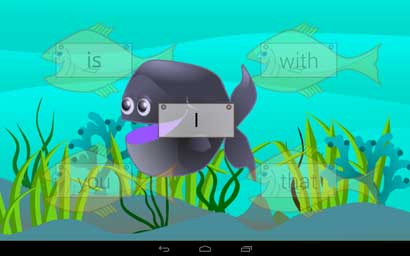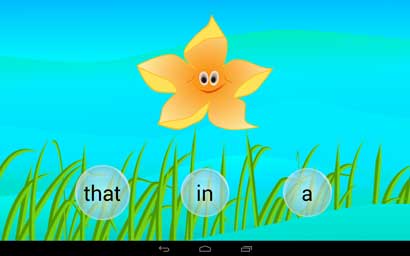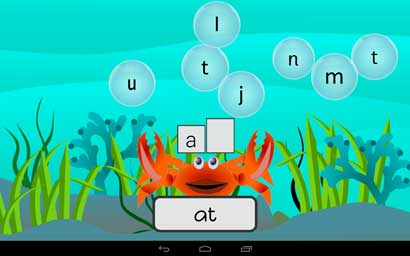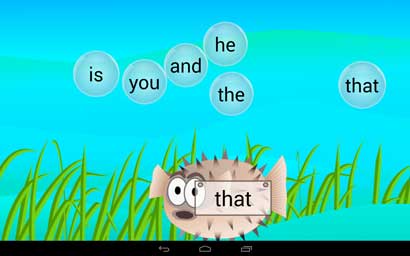More ideas for teaching Sight Words
Some Hints
- These activities will help encourage children to learn reading skills while memorising the words
- Sight words need to be known and read instantly
- The child shouldn’t need to attempt to sound out the words
- Allow some revision time to practise the words already mastered in earlier levels
Where do I get the word list?
Get a word list from the child’s teacher, download them from the resources section of our web site, www.parrotfish.com.au or do an internet search.
- Memory
- Make 2 copies of each sheet, preferably on card or something that you can’t see through. Cut out the words.
- Lay all the cards face down. Take turns, turning over a pair of cards, read each one, if they don’t match turn them back face down and try again. If the words match, the person who made the match takes the cards. The player with the most cards at the end of the game wins.
- Bingo
- Cut up a set of words and give the child a base board. You will need a set of counters, coins, lollies, smarties etc
- Give the child 1 or 2 base boards. Jumble up the word cards and call out a word. The child puts a token (coin, lolly) on the word. When they make a row – horizontal or diagonal – then they get to keep the tokens or eat the lollies. Make it competitive – only the first person to find the word gets the token. At first let them look at the word, progress to finding it only by listening and identifying
- Word Jig-Saws
- Cut each of the words in half horizontally. Have the child match the tops and bottoms of the words together. For initial support use the back boards to build the words on, later move on to building them without the base board.
- Cut each of the cards up into 4 parts like a jigsaw. Have the child reassemble the words and glue them onto a piece of paper. For added support match them and glue them on to the whole word.
- Spelling
- Print out a couple of sets of letters of the alphabet. Use a font that is similar to what is being taught at school, later pick some different fonts to assist with generalisation and awareness of different letter shapes.
- Make the words out of the letter cards. Start with a small set of letters – just the letters in the word, then build up with a few extra letters, then later with a full alphabet.
- Have the word in front of the child. Build the word out of the letters, either just above or on top of the word
- Look at a word, remember it – build the word out of letters without the cue card, as suggested start with a few letters. When the child gets stuck allow them to look at the word again and again try to remember it and turn it face down again before continuing.
- Memory – Hidden Words
- Look at a word, say and memorise it. Tell the child to shut their eyes and remember the word then look at it again.
Hide the word then ask the child to find the word on the base card. Look again at the word card and check to see if it is right. - Sentences
- Make up sentences using the sight words cards. Use some of the blank ones to add the child’s own words. Jumble up the sentence and have them rebuild it.
- In the early stages you may need to write the sentence so they can match the words to the sentence.
- Reread the sentences and jumble them up a few times. Try timing them to see if they get faster
- Uses of the Practice Checklist
- Print out the word list in your selected font.
- Use the list to map the child’s progress, tick the words that are read correctly from the flash cards. When 3 ticks in a row are achieved colour the word yellow
- Pre-test the child prior to commencing on the Parrotfish Sight Words Game App. Check progress each one to 2 weeks.
- Provide the list to the child to use as a spelling resource when writing.
- Cut the words up and use them to make silly sentences
- Make up sentences using the sight words cards. Use some of the blank ones to add the child’s own words. Jumble up the sentence and have them rebuild it.
- Look at a word, say and memorise it. Tell the child to shut their eyes and remember the word then look at it again.
Parrotfish sight words app is available in the Amazon, IOS and Android stores.
My Child is not reading well – is there a problem?
I was recently asked what to about an 8 year old child whose reading was not bad enough to warrant remedial help at school yet his mother felt that he wasn’t a competent reader.
By 8 many children are capable of reading independently. “The Hobbit” and novels of a similar difficulty would not be outside the interest or capability of many 8 year olds and yet standardised reading tests do not expect children to be able to read at this level.
The problem is that if they can’t read well by this age they often falter in increasing their reading skills and they just seem to stop progressing. There is very little targeted reading skill instruction in the primary years so many of these children go on to have difficulty completing work in later years. They can read – sort of – but so much energy and time is expended in reading that they struggle to complete tasks that involve reading.
Is there really a problem?
- Go for your gut feeling here. There are lots of tests but if something is worrying you then you are probably right.
- Listen to them read a real book, is it smooth or are they taking time to think out more than 20% of the words?
- Do they understand what they are reading – ask what the page was about?
- What do they do when they come across a word they can’t recognise. Look for use of different strategies
- Sound out a word
- Read past the word and go back and work out something that would make sense
- Break the word into syllables (parts)
- Attempt the word and say it so it is a word they recognise
- Make a rough attempt and move on (particularly if it is an uncommon word – names in Russian novels)
- Do they read alone or become “wrapped” in a book? If they giggle or share funny bits with you then you know they are understanding it. Not many kids will spend ½ an hour reading quietly if they don’t get it!
What can I do?
- Read to them every day – don’t let them miss out on enjoying books that are at their reading or interest level
- Don’t kill their confidence or risk taking – encourage use of all of the strategies above
- Check out their sight word and phonics knowledge. There are plenty of resources on the web. You will probably find that they are stronger in one area than the other and have learnt to rely on that skill only. Work on both.
- Find out what their strengths are, capitalise on them and use them to build confidence but also work on their weaknesses. Let’s try to build those pathways so they can use all the reading / decoding strategies available to them.
The ideas behind the Parrotfish Sight Words App
Some Hints
- This sight words app should be used in conjunction with a systematic decoding program and exposure to lots of literature to teach that meaning and enjoyment is of utmost importance and the real reason we learn to read.
- For a child to read fluently they must be able to decode efficiently and have a good body of instantly recognisable sight words. This frees them to spend their energy on comprehending the story.
- A good bank of sight words which can be recognised instantly, helps students gain success in reading. It gives them a structure around which to build other skills such as comprehension and decoding, and the confidence to take risks when reading texts.
- Most children will never need to be taught to the end of the list of 200+ words, as once they are really reading, many words will be learnt in context.
- Don’t force competent readers to continue on through the list, and certainly not in one year. It could take some learners 2 to 3 years to get through the list, typically the entire 200+ words should be mastered before the child is 8 years old, however, competent learners will know them all much earlier.
- You don’t need to wait until the child starts school, you can start introducing a child to sight words in the year before going to school.
- Don’t worry about what list of words you use – learning the reading and memory skills is what is important
- This app allows progress at the child’s rate, providing motivation through reward mechanics and instant feedback as they play the game
- Utilise all their learning modes. The app utilises auditory, visual and kinaesthetic learning / teaching modes
- Children need to generalise their newly acquired skills
- teach them to see words around them and in context,
- use different fonts
- ensure they hear the words with different accents and voices
- Above all try to keep learning fun
Why learn Sight Words?
What are Sight Words?
Sight Words – common words that cannot easily be sounded out by beginning readers so need to be recognised on sight
High Frequency Words – words that occur frequently in reading and writing, they make up more than half of the words that the child will encounter in their reading and writing
Why learn Sight Words?
The basic sight words make up about half the words that the beginning reader will be exposed to in their reading and writing so being able to recognise them quickly and write them easily is a big step to becoming a confident reader. A child should be able to read the majority of words in a text before they are asked to attempt to read it, so having a bank of words they can recognise allows them to concentrate on meaning.
Where do I find the Sight Words List?
There are lots of different lists of sight words – Dolch, Fry, and Magic 100 are most commonly used in schools. There are about 100 basic words but the lists can go on to up to 350 words.
An internet search will provide lots of lists or see the links at the end of this article for lists to match our Parrotfish Sight Words App.
What are the lists different?
Sometimes these lists will be ordered in years that the child will be learning them and sometimes in order of frequency in the written language. Although many of the words on the lists may differ due to the year that they were developed, the geographical location, empirical data and samples used, it doesn’t really matter what list is used. What is important is that the child is learning to use memory skills and developing strategies to memorise these words. These strategies will later be applied to lots of different learning situations – not just reading.
How can I help?
Parents can assist this learning by practising the words with them using games and getting them to read the words from flash cards at increasing speed. See my article on “Ideas for Learning Sight Words”.
Our app-Parrotfish sight words has 6 different games that require different reading strategies. This app has been proven to work, is great for practising the words and gives immediate feedback.
See our website for downloads of word lists and more ideas for developing reading skills:
www.parrotfish.com.au
The Games in the Parrotfish Sight Words App
Peter Puffs
The child has to match words in bubbles to the words on the fish by dragging the all matching words on to Peter the puffer fish. For each word correct the fish blows up a little. A second, red toned fish follows, it carries the same word but moves a bit faster. The red fish is a bit tricky, we are building instant recognition.
Super Shelly
This is a classic memory game. They tap 2 cards, read and remember where they are to find the matching words. The words are repeated each time they are turned over and again before they leave the screen. Loads of repetition here.
Wally’s Words
The whale comes on the screen and the word is repeated a couple of times. It then disappears and 5 fish appear each with a different word. The child has to identify the word that was on the whale.

Stella Stars
The star says a word. The child has to find the word that Stella says and drag it on to her. They can tap Stella at any time to hear the word again.

Crabby Clara
The crab holds up cards showing the word shape. The word is written below the cards. The letters that spell the word need to be dragged onto the cards in the correct order to spell out the word. They can tap Clara to hear her repeat the word.

Edgars Eggs
This requires memory and logic. There is a word shown on the egg, it slowly disappears but can be shown again by tapping it. They are to read and remember the word in Edgar’s egg then only tap the words that don’t match the word in the egg. The egg grows and hatches.
How to Help them Learn their Sight Words
These ideas will help kids spell, identify and remember their sight words – the activities are grouped in order of difficulty.
Being able to spell the words correctly isn’t necessary but since these words make up such a large percentage of our written language being able to write them will help with confidence in written tasks.
For each set of words the child has to learn you will need:
- Word list as a grid (provided by the school or from our download tab on the Sight Words Game page
- Words cut up as flash cards (you need two sets for some activities)
- It is also good to have a master list of all the words that they will be learning so you can regularly test up to what they know and put ticks or crosses against the word. Regularly review the words that caused problems
Print to Print –
- Rainbow words – Write the words and trace each one in lots of different colours – use pencils, textas, chalk . .
- Spaghetti words – write the words then cover them by making the letters out of cooked spaghetti, wait for the spaghetti to cool – no burnt fingers please!
- Match Up – Use a timer, put the base grid down and all of the words on flash cards face down nearby. Start the timer – they turn a card and place it on the matching word on the grid. When they are good at that require them to read the word before placing it. Time each attempt record the best times
- Snap – This is good for revision, you can use all the cards from previous weeks. You need at least 2 copies of each word card. Split the deck among the players. Take turns putting the top card down on a centre pile as they say the word. If the word matches the one previously played anyone can call “SNAP” and place their hand on the pile. They get the pile of words. The person who has most words at the end of the game wins.
- Sticky – Make the words with a drizzle of white glue and let it dry – they trace the letters with their fingers
- Word hunt – look for words they know in the book you are going to read them, while shopping or on food labels
Verbal to print – identifying the spoken word
- What am I – spread the words out, just say the word, they find it
- Grab – spread the words out face up, have a person call out a word, the first person to grab a word keeps it. Try it face down, they need to turn the word and replace it face down if it is not the one they are looking for
- Find Me – say a words and have them find it in a book or while out shopping
Print to Verbal – Reads the word
- Hints – spread the words out – give clues, “I start with a ‘b’”, “ I am a long word”, “I sound like ___”, “I have 3 letters”, “I end with a _”
- Read the words on flash cards or the master list
Letter recognition – words are made of parts
- Chalk Board – Copy the words on to a chalk board (or paving, driveway )
- Fence Painting – write on the fence or pavement with a paint brush dipped in water
- Write it how? – use a large piece of paper, write it big, write it tiny, write it sideways . . .
- Sand Paper – On the beach, in the dirt, take any opportunity – write the words with a finger, with a stick . . .
Apps and computer games
There are lots of Apps and computer games that teach sight words. A search on any of the stores will give you plenty to choose from.
